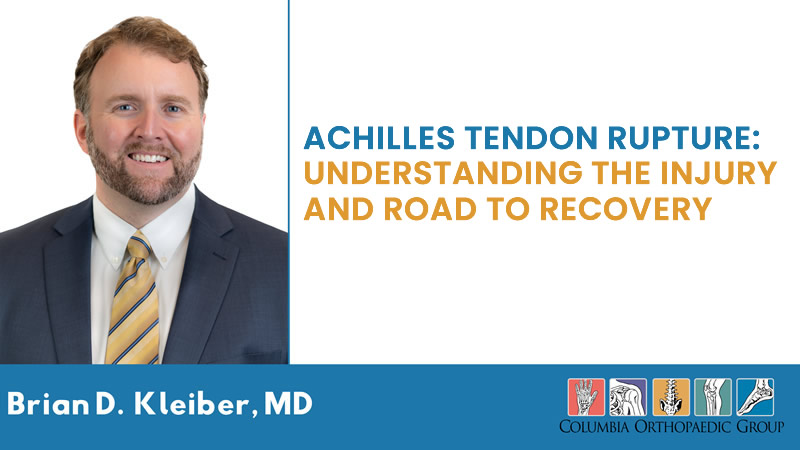
Achilles Tendon Rupture: Understanding the Injury and Road to Recovery
The Achilles tendon, named after the Greek mythological hero Achilles, is the largest and strongest tendon in the human body. It plays a crucial role in our ability to walk, run, and jump. However, this powerful tendon is not immune to injury, and one of the most debilitating conditions it can face is a rupture. In this blog, we will explore what an Achilles tendon rupture is, its causes, symptoms, diagnosis, treatment options, and the journey to recovery.
What is an Achilles Tendon Rupture?
An Achilles tendon rupture occurs when the fibrous tissue that connects the calf muscles to the heel bone tears or breaks. This injury is often characterized by a sudden and sharp pain in the back of the ankle, usually described as feeling like a "snap" or "pop." Achilles tendon ruptures can vary in severity, from partial tears to complete ruptures, but they always require prompt attention and treatment.
Causes of Achilles Tendon Rupture
Several factors can contribute to the development of an Achilles tendon rupture:
- Overuse: Repetitive stress on the tendon due to activities such as running or jumping can weaken the tendon over time, making it more prone to injury.
- Age: The risk of an Achilles tendon rupture increases with age, as the tendon tends to lose its elasticity and strength over time.
- Sudden, intense physical activity: Engaging in activities that your body is not accustomed to, like sprinting or jumping, can put excessive strain on the tendon and lead to a rupture.
- Poor footwear: Wearing shoes that do not provide proper support or are worn out can increase the risk of injury.
- Chronic conditions: Certain medical conditions, such as tendinitis or rheumatoid arthritis, can weaken the Achilles tendon and make it more susceptible to rupture.
Dr. Brian Kleiber, a board certified foot and ankle specialist with the Columbia Orthopaedic Group, says Achilles tendon ruptures are not an uncommon injury in the physically active 25 to 45 year old population. It is extremely common for the patient to report feeling like somebody hit them in the back of the leg. In order to have the best treatment options available, it is highly recommended to see an orthopaedic surgeon soon after the injury. Regardless of the treatment option, it likely will take 8 months to a year for the patient to feel that they have nearly fully recovered. Even professional athletes tend to follow a similar timeline in terms of return to play.
Symptoms and Diagnosis
Recognizing the signs and symptoms of an Achilles tendon rupture is crucial for early diagnosis and treatment. Common indicators include:
- Sudden, severe pain in the back of the ankle or calf.
- A popping or snapping sensation at the time of injury.
- Swelling and bruising around the affected area.
- Difficulty or inability to point the toes or push off with the affected foot.
- A noticeable gap or indentation in the Achilles tendon area.
A healthcare professional can typically diagnose an Achilles tendon rupture through a physical examination, discussing your medical history, and sometimes using imaging tests like an ultrasound or MRI to confirm the extent of the injury.
Treatment Options
The treatment approach for an Achilles tendon rupture depends on the severity of the injury, the patient's age, activity level, and overall health. Common treatment options include:
- Non-surgical Management: For partial tears or less severe ruptures, conservative treatment options like immobilization in a cast or brace, physical therapy, and rest may be recommended.
- Surgical Repair: Complete Achilles tendon ruptures often require surgery to reattach the torn ends. Various surgical techniques may be employed, such as open surgery or minimally invasive procedures.
Recovery and Rehabilitation
Recovery from an Achilles tendon rupture can be a lengthy process, typically taking several months. Here's what you can expect during your road to recovery:
- Immobilization: After surgery or non-surgical treatment, your foot and ankle will be immobilized in a cast, boot, or brace for a period determined by your healthcare provider.
- Physical Therapy: Physical therapy plays a crucial role in restoring strength, flexibility, and function to the Achilles tendon and calf muscles.
- Gradual Return to Activity: Your healthcare provider will guide you through a structured rehabilitation program, gradually reintroducing weight-bearing and strengthening exercises.
- Patience and Persistence: Recovery may be frustrating at times, but it's essential to follow your healthcare provider's advice and stick to your rehabilitation plan.
An Achilles tendon rupture is a challenging injury that can significantly impact your daily life and physical abilities. However, with timely diagnosis, appropriate treatment, and a dedicated rehabilitation plan, most individuals can recover and regain their strength and mobility. If you suspect you have an Achilles tendon injury, consult a healthcare professional promptly to receive the care and support needed for a successful recovery. Remember, patience and persistence are key to coming back stronger than ever.
Dr. Kleiber is a board-certified, fellowship-trained Orthopaedic surgeon specializing in the surgical and nonsurgical treatment of the foot and ankle.
 For an appointment with Dr. Kleiber, call (573) 876-8141.
For an appointment with Dr. Kleiber, call (573) 876-8141.
